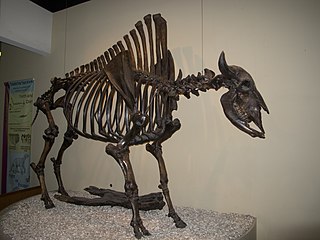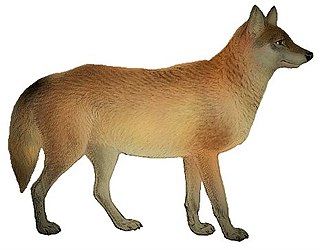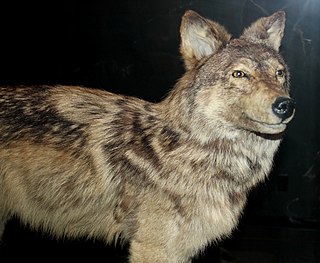 W
WArchiinocellia is an extinct monotypic genus of Snakefly containing the single species Archiinocellia oligoneura.
 W
WThe great auk is a species of flightless alcid that became extinct in the mid-19th century. It was the only modern species in the genus Pinguinus. It is not closely related to the birds now known as penguins, which were discovered later and so named by sailors because of their physical resemblance to the great auk.
 W
WThe Beringian wolf is an extinct kind of wolf that lived during the Ice Age. It inhabited what is now modern-day Alaska, Yukon, and northern Wyoming. Some of these wolves survived well into the Holocene. The Beringian wolf is an ecomorph of the gray wolf and has been comprehensively studied using a range of scientific techniques, yielding new information on the prey species and feeding behavior of prehistoric wolves. It has been determined that these wolves are morphologically distinct from modern North American wolves and genetically basal to most modern and extinct wolves. The Beringian wolf has not been assigned a subspecies classification and its relationship with the extinct European cave wolf is not clear.
 W
WBison antiquus, the antique or ancient bison, is an extinct species of bison that lived in Late Pleistocene North America until around 10,000 years ago. It was one of the most common large herbivores on the North American continent during the late Pleistocene, and is a direct ancestor of the living American bison along with Bison occidentalis.
 W
WThe Cascade Mountains wolf is an extinct subspecies of the gray wolf that was once found in the Pacific Northwest. The wolf became extinct in 1940. It was originally identified as a separate species by Richardson in 1839 and from other wolves in the area by Edward Goldman in 1945. This wolf is recognized as a subspecies of Canis lupus in the taxonomic authority Mammal Species of the World (2005). It was described as a cinnamon-coloured wolf, measuring 165 cm and weighing 36–49 kg.
 W
WEastern cougar or eastern puma refers to the extirpated population of cougars that live in northeastern North America, which some authorities have considered to be a subspecies. The eastern cougars were unofficially deemed extinct by a U.S. Fish and Wildlife Service evaluation in 2011. The U.S. Fish and Wildlife Service formally removed the eastern cougar from the endangered species list and declared it to be extinct in 2018. The Canadian Wildlife Service has taken no position on the question. Cougars are still common in western North America; individuals from that population are occasionally seen in the eastern cougar's former range.
 W
WThe eastern elk is an extinct subspecies or distinct population of elk that inhabited the northern and eastern United States, and southern Canada. The last eastern elk was shot in Pennsylvania on September 1, 1877. The subspecies was declared extinct by the United States Fish and Wildlife Service in 1880. Another subspecies of elk, the Merriam's elk, also became extinct at roughly the same time.
 W
WGabriceraurus is a trilobite in the order Phacopida, that existed during the upper Ordovician in what is now Canada. It was described by Pribyl and Vanek in 1985, and the type species is Gabriceraurus gabrielsi, which was originally described under the genus Ceraurus by Ludvigsen in 1979. The type locality was the Esbataottine Formation in the Northwest Territories.
 W
WThe giant pika or Wharton's pika is an extinct mammal species in the family Ochotonidae. It lived during the Pleistocene and early Holocene in northern parts of North America. Very similar forms have also been found also in Siberia.
 W
WThe High Arctic camel, from the mid-Pliocene epoch, is a fossil camel related to the fossil genus Paracamelus from which modern camels arose. It is also related to the extinct Ice Age Yukon giant camel. Collagen-containing fossils were found in 2006 near Strathcona Fiord on Ellesmere Island in Nunavut, Canada. The High Arctic camel lived at least 3.4 million years ago during a warmer period in a boreal-type forest environment.
 W
WThe Labrador duck was a North American bird; it has the distinction of being the first endemic North American bird species to become extinct after the Columbian Exchange, with the last known sighting occurring in 1878 in Elmira, New York. It was already a rare duck before European settlers arrived, and as a result of its rarity, information on the Labrador duck is not abundant, although some, such as its habitat, characteristics, dietary habits and reasons behind its extinction, are known. There are 55 specimens of the Labrador duck preserved in museum collections worldwide.
 W
WA mastodon is any proboscidean belonging to the extinct genus Mammut that inhabited North and Central America during the late Miocene or late Pliocene up to their extinction at the end of the Pleistocene 10,000 to 11,000 years ago. Mastodons lived in herds and were predominantly forest-dwelling animals that lived on a mixed diet obtained by browsing and grazing, somewhat similar to their distant relatives, modern elephants, but probably with greater emphasis on browsing.
 W
WThe Newfoundland wolf is an extinct subspecies of grey wolf that was native to Newfoundland. It is described as being a medium-sized, slender-skulled wolf with a white pelt, though melanists also occurred. In comparison to its mainland relatives it bears a striking difference in its internal accessory cusp angles allowing for distinction between subspecies. The last specimen was reportedly killed in 1911. This wolf is recognized as a subspecies of Canis lupus in the taxonomic authority Mammal Species of the World (2005). In 1912, Gerrit S. Miller Jr have concluded that in North America, specifically west of the Mississippi River and Hudson Bay, and north of the Platte and Columbia rivers, there are three types of wolves: timber-wolf, plains-wolf, and tundra-wolf.
 W
WThe passenger pigeon or wild pigeon is an extinct species of pigeon that was endemic to North America. Its common name is derived from the French word passager, meaning "passing by", due to the migratory habits of the species. The scientific name also refers to its migratory characteristics. The morphologically similar mourning dove was long thought to be its closest relative, and the two were at times confused, but genetic analysis has shown that the genus Patagioenas is more closely related to it than the Zenaida doves.
 W
WThe Queen Charlotte Islands caribou or Dawson's caribou is an extinct subspecies of the reindeer that once lived on Graham Island, the largest of the Haida Gwaii islands in British Columbia, Canada. Possible causes of extinction include habitat destruction, introduced disease and overhunting. It was grey in appearance. The last three caribou were killed in 1908 and can be seen at the Royal British Columbia Museum, where their pelts and bones are preserved and displayed. Recent analysis of mtDNA suggests that the Queen Charlotte Islands caribou was not genetically distinct from the subspecies from the Canadian mainland.
 W
WThe sea mink is a recently extinct species of mink that lived on the eastern coast of North America around the Gulf of Maine on the New England seaboard. It was most closely related to the American mink, with continuing debate about whether or not the sea mink should be considered a subspecies of the American mink or a species of its own. The main justification for a separate species designation is the size difference between the two minks, but other distinctions have been made, such as its redder fur. The only known remains are bone fragments unearthed in Native American shell middens. Its actual size is speculative, based largely on tooth remains.
 W
WWhiteia is an extinct genus of prehistoric coelacanth fish which lived in Madagascar and Canada during the Early Triassic period.
 W
WThe woolly mammoth is an extinct species of mammoth that lived during the Pleistocene until its extinction in the Holocene epoch. It was one of the last in a line of mammoth species, beginning with Mammuthus subplanifrons in the early Pliocene. The woolly mammoth began to diverge from the steppe mammoth about 800,000 years ago in East Asia. Its closest extant relative is the Asian elephant. The appearance and behaviour of this species are among the best studied of any prehistoric animal because of the discovery of frozen carcasses in Siberia and Alaska, as well as skeletons, teeth, stomach contents, dung, and depiction from life in prehistoric cave paintings. Mammoth remains had long been known in Asia before they became known to Europeans in the 17th century. The origin of these remains was long a matter of debate, and often explained as being remains of legendary creatures. The mammoth was identified as an extinct species of elephant by Georges Cuvier in 1796.